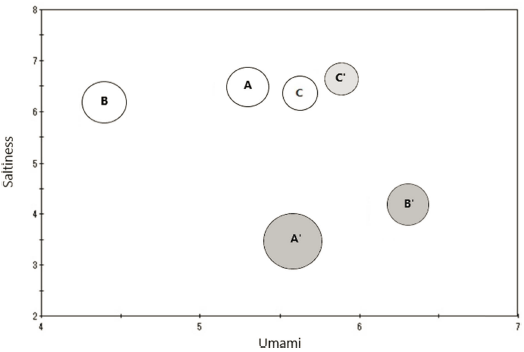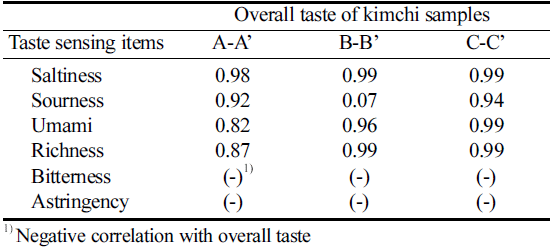Introduction
A balanced salt content is important for a healthy diet, as improper sodium intake can have a direct impact on cardiovascular parameters. In Korea, kimchi forms a part of all the major meals, with an average consumption of about 68.6 g of kimchi in a day, that accounts for almost 25% of their daily sodium intake (MFDS, 2016;KMHW, 2013).
It is known that the quality and taste of kimchi is intricately correlated with the salt content used during its preparation. Salt is required to eliminate the bitter taste to produce an umami taste, and further, for facilitating efficient fermentation by lactic acid bacteria to yield the characteristic sour taste resulting from the accumulation of organic acids such as lactic acid (Park, 2002;Mheen & Kwon, 1984). It has been reported that the saltiness of kimchi prepared by manufacturers is around 2.38% and that of home-made kimchi is 3.04% (Yi et al., 2009). Though low-salt kimchi can compromise the taste and quality of the product, it is beneficial for maintaining physiological fitness in terms of blood pressure and cardiovascular functions (He & MacGregor, 2002;He & MacGregor, 2006;Strazzullo et al., 2009;Bibbns-Domingo et al., 2010).
In a study of fermentation characteristics of low-salt kimchi, Moon et al. (2014) reported instances where the optimum salinity of normal kimchi had been set to 3.0%. However, 2.0% and 1.0% salinity are actually defined for conventional kimchi and kimchi for patients, respectively (Moon et al., 2014). Furthermore, some research evidences consider lowsalt kimchi as that with salinity less than 2.0% (Kim, 1985;Kim et al., 1988;Cho et al., 2005).
Currently, commercial kimchi manufacturers have opted to produce low-salinity kimchi, with up to 30% reduction in salt content compared to the conventional product (2.0-2.5% salinity), thereby, reducing the sodium content from 790 mg to 620 mg per 100 g of kimchi (MFDS, 2016). The cost of such a reduction would be the possible alterations in the taste of kimchi and the enhanced safety concerns caused by probable abnormal fermentation processes because of altered fermenting microbial populations. This would also amount to distinct fermentation metabolite profiles, and different intensities of umami and sour tastes (Jin et al., 2007;Yu & Hwang, 2011). Further, various components from ingredients supplemented for buffering saltiness and umami taste would have an effect on the overall taste of low-salinity kimchi (Jang et al., 1991). Therefore, it would be a pertinent measure to evaluate the quality of kimchi in terms of tastes and flavors during its preparation because minute changes of taste might increase to unacceptable levels following the addition of buffering ingredients, and during storage and delivery. With this premise, the current study aims to analyze the different tastes of commercially available low-salinity kimchi as compared to the conventional ones.
Materials and Methods
Commercially available normal and low-salinity Napa cabbage (Brassica rapa Pekinensis) kimchi were procured from domestic kimchi manufacturing companies located in Hongseong, Daejeon and Changwon and marked as A, B and C for normal salinity kimchi products of each make, respectively. Correspondingly, the low-salinity kimchi variants from each make were designated as A’, B’, and C’. All the kimchi samples were stored at 4 °C and used for analysis after pretreatment.
For measuring pH and salinity of kimchi, 25 mL of supernatant obtained from kimchi ground with a blender was measured using a pH meter (420 Benchtop, Orion Research, Beverly, MA, USA) and with a New Salt-Tester (DMT-20-1, 0-5%, Seoul, Korea), respectively.
For preparing samples for taste sensing analysis, kimchi sample (30 g) was blended in 100 mL distilled water with a food mixer (HM-1270 Food mixer, Hanil Electric Inc., Seoul, Korea), and then filtered with sterilized gauze. The filtrate was centrifuged (1,430 × g, 10 min) using a table-top centrifuge (Union 32R, Hanil Scientific Inc., Gimpo, Korea) and the supernatant was collected for taste sensing.
Taste analyses for kimchi samples were conducted using a Taste sensing system (TS-5000Z, Insent Inc., Atsugi, Japan) equipped with taste sensors. The results of the taste analysis are depicted as the mean of data obtained from technical triplicates for each sample (35 mL). Taste sensing items were umami, richness, bitterness, astringency, saltiness, and sourness.
Sensory evaluation (9-point scale) was performed on 30 student panels of food science major where 30 g kimchi samples were presented. Each panel was asked on overall taste of kimchi samples for a blinded analysis. Drinking water and cooked rice were also given to wash out residual taste of previous sample. Correlation coefficients for the overall taste and the taste sensing items of kimchi samples were obtained with the respective data of each conventional kimchi and lowsalinity kimchi samples.
The data are represented as the mean±standard deviation for triplicate values. Statistical significance was calculated using Student’s t-test in the SPSS software (Statistical Package for the Social Sciences, Version 21.0, SPSS Inc., Chicago, IL, USA). p < 0.05 is considered significant.
Results and Discussion
The commercial normal Napa cabbage kimchi is produced by adding seasoning agents into the desalted Napa cabbage after incubating the cabbage in 10-15% saline solution for 15- 20 h (Kim, 1997). On the contrary, low-salinity kimchi A’ is prepared by immersing the cabbage into 7% saline solution for 16-18 h before adding the seasonings. It was found that the overall taste of low-salinity kimchi A’ (4.1±1.2) is lower than that of normal kimchi A (5.3±1.5) (Table 1).

|
A comparison of the taste characteristics indicated a significant difference in the saltiness of the two samples, with sample A’ (salinity: 1.2-1.4%) showing a value of 3.51±0.04, and sample A (salinity: 1.8-2.0%) showing a value of 6.55 ±0.04 (Table 1). These differences were predicted to result from lowering the salinity of Napa cabbage and the seasonings used for preparing A’. However, the umami taste of sample A’ (5.65±0.02) was not found to be significantly different from that of sample A (5.25±0.02), indicating that the added kimchi seasonings such as kelp extract complement the umami of low-salinity kimchi (Fig. 1). Kelp extract has been used for complementing flat taste of low-salt sauced anchovies (Kim, 2016) and alginic acid contained in kelp absorbs sodium during the manufacturing process of low-salinity kimchi (Ha & Park, 2000).

Although sourness of low-salinity kimchi increases rapidly compared to that of normal kimchi due to the activation of lactic acid fermentation during aging process, the difference of sourness between samples A and A’ was not significant at the initial stage of aging. In addition, the difference in umami was also not significant, however, the bitterness and astringency of sample A’ was found to be significantly higher than those of sample A (Table 1).
Evidences suggest an relationship of salinity with the pH of kimchi, depicting a significant increase in acidity of kimchi upon reduction in the salting concentration of Napa cabbage (Park, 2002). Park and Kim (1991b) found that the acidity of cabbage with 1% salinity increases to 0.32% after storage for 2 days at 25 °C, but that for cabbage with 5% salinity remains only 0.2%. Thus, it could be derived that the acidity of lowsalinity kimchi increases at an earlier stage compared to the case for normal salinity kimchi.
Contrary to these evidences regarding the effects of pH, we observed no difference in the sourness of the two samples, both of which were found to be less than the critical levels (-6) for human sensing. This observation may be explained by the insufficient lactic acid fermentation of kimchi aged only 7 days at 4°C. Based on the above results, we conclude that the overall taste of low-salinity kimchi (A’) is lower than that of normal-salinity kimchi (A), because the saltiness of A’ (3.51±0.04) was lower than that of A (6.55±0.04) and its bitterness (8.55±0.08) was higher than that of A (7.65±0.15), with no significant difference in the umami taste (Table 1).
Therefore, determining a critical threshold value of saltiness for low-salinity kimchi that does not negatively influence the overall taste may be considered. Park and Jung (2006) have reported that the saltiness confers preferable effects on the overall taste of commercial kimchi. For instance, it has been suggested that kimchi prepared with Napa cabbage brined at 15% salt solution exhibits desired pH, acidity, and texture, showing 2.49% salinity (Park, 2002). This was in line with observations made by Song et al. (1995), where they reported the salinity of most delicious kimchi to be witnin the range of 2.6-2.8%.
Low-salinity kimchi B’ was produced by adding seasonings into the desalted Napa cabbage, brined in 11% saline solution for 18 h. When taste characteristics were compared between B’ and B, saltiness of sample B’ (salinity: 1.6-1.8%) was 4.25±0.02, which was significantly lower than that of sample B (salinity: 2.2-2.3%), which was 6.23±0.03, but higher than that of sample A’ (salinity: 1.2-1.4%), which was 3.51±0.04 (Table 1 and 2).

|
Although sourness of low-salinity kimchi B’ (-17.68±0.18) was below -6 (critical level for human sensing), it was found to be stronger than that of normal salinity kimchi B (-20.22 ±0.28). It has been reported that a high enough salt concentration of kimchi lowers its acidity (Park and Kim, 1991b). Likewise, our observations of lower sourness of normal salinity kimchi B (2.2-2.3%) may be explained by the possible suppression of lactic acid fermentation. No significant difference was observed between the bitterness of the two samples. Park and Lim (2003) reported that the overall preference would be lowered if the salinity of kimchi exceeds 2.0% because of the reduced sourness, hot taste, sweetness and umami, thereby suggesting an optimum salinity for kimchi to be below 2.0%.
With these taste sensing results for low-salinity kimchi B’, we observed a stronger saltiness and umami for sample B’ than for sample A’ (Fig. 1). We expected that larger quantities of condiments and Jeotgal were used for preparing sample B’ than for preparing sample A’ based on umami scores (Fig. 1). However, according to Park and Kim (1991a), the amounts of Jeotgal used in kimchi does not always show a positive relationship with the overall acceptance of the taste of kimchi.
Low-salinity kimchi C’ was produced by adding seasonings into the desalted Napa cabbage, brined in 12% saline solution for 12 h. When taste characteristics were compared between samples C’ and C, saltiness of sample C’ (salinity: 1.9-2.0%) was found to be 6.70±0.02, which was not significantly different from that of sample C (salinity: 2.0-2.1%), 6.46±0.03 (Table 3). In addition, it may be observed in Table 3 that there were no significant differences in other tastes between samples C’ and C. Moreover, the salinity of C’ (1.9-2.0%) and C (2.0- 2.1%) were found to be similar, indicating the inefficacious process of salinity reduction in C’.

|
Correlation coefficients were calculated to assess the relationship between the overall tastes through sensory evaluation and taste sensing items of kimchi (Table 4). Between A and A’, saltiness showed the highest correlation with overall tastes through sensory evaluation and umami showed positive correlation. Moreover, between B and B’ saltiness showed the highest correlation, however bitterness and astringency showed negative correlation. Saltiness and umami showed the highest correlation with overall taste and preference through sensory evaluation for C and C’, but bitterness and astringency showed negative correlation. There was no significant difference in sourness possibly because of the early stage of lactic acid fermentation. When the taste sensing results of low-salinity kimchi were considered together, the overall taste and preference of low-salinity (below 2.0%) kimchi showed the highest positive correlation with the degree of saltiness, followed by umami.

|
These results clearly show that it is necessary to develop alternative special additives for enhancing the taste of kimchi to compensate for the possible reduction in the overall taste and preferences for commercial low-salinity kimchi.







